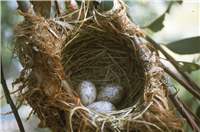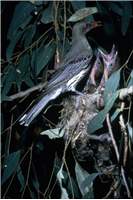Family
Oriolidae
Genus
Oriolus
Species
sagittatus
Threats/Control Methods - Regional
Orioles may cause a threat of spreading weed varieties like blackberries into our nearby woodlands and forests.
Threats/Control Methods - Local
This species nests in the summer across the Canberra region and therefore their young are at predation risk from Cats (Felis catus) and large birds like the Pied Currawong (Strepera graculina ).
Local/Urban Actions
Fruit trees can be protected from these hungry birds by netting or sound and visual deterrents.
Common Names
Olive-baked Oriole, Green Thrush, Oriole, Cedar Bird
Distinguishing Features
This species is 25-28cm in size with a fairly slim body and a strong bill. The males are recognisable for their red eye and pink bill. Their head, back and rump plumage is olive-green, while their wings and tail are grey. The female has a paler brown bill and a dull olive head and back with brown streaks. Both sexes have dark streaks across their white underparts.
Survey Techniques
Call and visual identification.
Species Call
A clear, mellow and musical sequence of 'orry-orry-orriole'.
Similar Species
In this region of Australia, the only similar species is the slightly larger Figbird (Sphecotheres viridis) with its unique black head and red bare skin around the eye.
Distribution
The Olive-backed Oriole is found from the Kimberlys in the northwest, across the top of NT and right throughout QLD, NSW and VIC, into SA to Adelaide.
Country of Origin
Australia
Conservation (Pet/Pest) Status - Regional
The population appears stable (COG).
Conservation (Pet/Pest) Status - National
Secure, not listed under the EPBC Act 1999.
LSCCES Population
One bird was sighted at the ANU.
Associated vegetation community
This species inhabits forest, woodland, rainforest and urban green spaces like golf courses.
Limiting Resources
This species is limited to where is can find fruit trees easily.
Breeding
The breeding season of the Olive-backed Oriole runs from September to January. The female builds a deep, cup-shaped nest in the outer foliage of a tree or shrub. 2-3 cream eggs, spotted with grey and brown are incubated for 18 days. After hatching, the male feeds young in nest for about 17 days.
Behaviour
The Orioles are seasonally migratory, spending time in Canberra from mid spring to late summer, following fruiting trees. They are very vocal as they move back into the suburbs in spring. They can be seen feeding in the canopy of fruit trees, either singularly or in pairs, sometimes seen feeding with Figbirds (Sphecotheres viridis).
Functional Group
Food Species
The Olive-backed Oriole spends its time in fruit-bearing trees eating insects, fruits and berries. Some of the most popular fruit trees include the Small-fruited Fig, (Ficus macrocarpa), White Cedar (Melia azaderach) and the Native Peach (Trema aspera).
Predators
Cats (Felis catus) and large birds like the Pied Currawong (Strepera graculina ).
Interesting Fact
Established breeding pairs sing to one another regularly throughout the year, perhaps as a way to help maintain a strong bond.
References - (reader suitability of references, P=Primary teachers, S=Secondary students, T=Tertiary students and researchers)
Books:Morcombe, M. 2000. Field Guide to Australian Birds. Steve Parish Publishing. Archerfield. Australia P, S, T
Schodde, R. and Tideman, S. (eds) 1990. Reader's Digest Complete Book of Australian Birds (2nd Edition). Reader's Digest Services Pty Ltd. Sydney. P, S, T
Veerman, P. 2003. Canberra Birds: A report on the first 21 years of the garden bird survey. Philip Veerman and Canberra Ornithologists Group. Canberra. S, T
Internet: Birds in Backyards. 2006. [online]. Available at:http://www.birdsinbackyards.net P, S, T
Canberra Ornithological Group (COG). 2004. Birds of Canberra Gardens. COG and the ACT Department of Urban Services. [online]. Available at:http://garden.canberrabirds.org.au/ P, S, T
Online Publications:Nix, H. and Cunningham, R. 2006. Birds of the Lower Sullivans Creek Catchment, Canberra ACT. Prepared for the Life in the Suburbs project using data from the Lower Sullivans Creek Catchment Ecological Survey (LSCCES). Australian National University. Canberra. [online]. Available at: http://www.lifeinthesuburbs.com.au/category.php?id=65 S, T



 Top
Top Top
Top